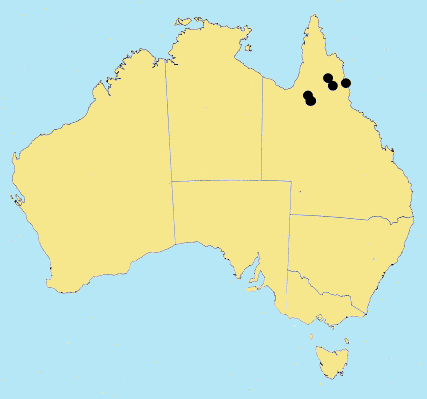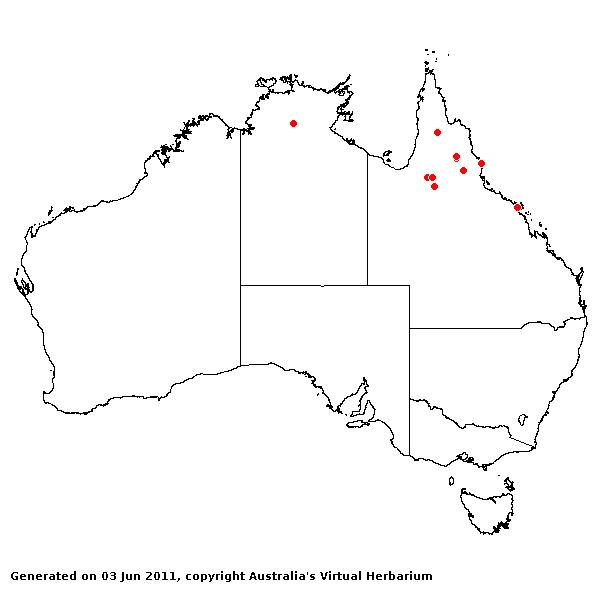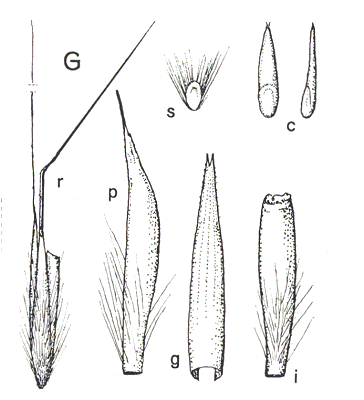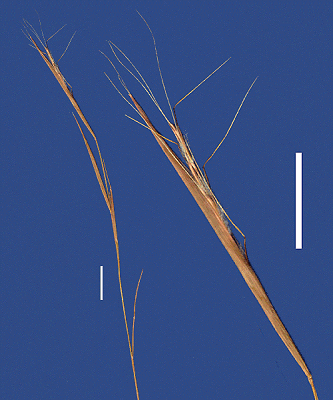Schizachyrium dolosum S. T. Blake. Contr.
Queensland Herb. 17: 26 (1974).
Classification. (GPWG 2001) : Subfamily
Panicoideae. Andropogoneae.
Type of Basionym or
Protologue Information: IT: S.T. Blake 19617, 18 Jul 1954,
Australia: Queensland, Burke, Esmeralda, 13 m (L).
Key references (books
and floras): [2002] D.Sharp & B.K.Simon, AusGrass, Grasses of
Australia.
Habit. Annual.
Culms 50–100 cm tall, 0.35–0.8 mm diam., 7–11 -noded. Lateral branches sparsely
branched or branched. Leaf-sheaths smooth. Ligule an eciliate membrane, 0.2–1
mm long. Leaf-blades conduplicate or convolute, 2–6 cm long, 0.8–1.5 mm wide.
Leaf-blade surface scaberulous.
Inflorescence.
Inflorescence solid or compound, a rame, a panicle of rames. Rhachis fragile at
the nodes.
Spikelets.
Spikelets sessile, 1 in the cluster. Companion spikelets pedicelled, 1 in the
cluster. Companion spikelets rudimentary, comprising 2 unequal glumes without
lemmas, 1–1.5 mm long. Companion spikelet glumes awned. Fertile spikelets
2-flowered, the lower floret barren (rarely male), the upper fertile,
comprising 1 basal sterile florets, comprising 1 fertile floret(s), without
rachilla extension, lanceolate or ovate, laterally compressed, 4.3–8 mm long.
Glumes.
Glumes dissimilar, firmer than fertile lemma. Lower glume lanceolate,
coriaceous, keeled, 2-keeled, wingless. Lower glume surface glabrous or
indumented. Upper glume lanceolate, membranous, keeled, 1-keeled, 1 -nerved.
Upper glume apex mucronate. Florets. Basal sterile florets 1, barren,
without significant palea. Lemma of lower sterile floret 80 % of length of
spikelet, hyaline, 0 -nerved.
Fertile lemma without
keel, 1 -nerved. Lemma apex lobed, awned, 1 -awned. Median (principal) awn from
a sinus, 12–18 mm long overall, with a twisted column. Column 5–8 mm long.
Palea absent. Grain 2.3–2.5 mm long.
Continental
Distribution: Australasia.
Australian
Distribution: Queensland.
Queensland:
Burke, Cook.
Notes. An
annual found in sandy soils of northern Qld usually associated with other Schizachyrium
species. Flowers Mar.--Apr. and July.




